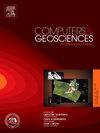烟雾或云:野火数据集成应用中的实时卫星图像分割
IF 4.4
2区 地球科学
Q1 COMPUTER SCIENCE, INTERDISCIPLINARY APPLICATIONS
引用次数: 0
摘要
先进的卫星数据越来越多地用于野火探测和监测,但由于气溶胶污染,GOES-R系列的近实时热点数据产品往往具有较低的置信度。由于气溶胶污染会影响GOES-R热点检测算法的置信度,无论是火灾指示烟雾还是假阳性指示云的污染,区分烟雾和云都有可能提高实时热点检测的准确性。本文的主要贡献是一个多类烟雾和云分割模型,该模型可以在实时应用中对GOES-R真彩色图像中的烟雾、云和两者都进行分类。在选择最终模型时,我们进行了一个实验来检验自监督学习对不同模型架构的影响。最后一个模型是一个U-Net模型,使用Barlow Twins自监督学习对超过10,000张图像进行预训练,并使用监督学习进行微调,其性能与更大更慢的ResUnet模型相当。我们的模型在现有的基于卫星的烟雾分割的基础上进行了改进,在测试集上具有85%的准确率和68%的平均相交过集。该模型部署在野火管理开放数据集成(ODIN)应用程序中,允许实时烟雾和云检测,以提高对烟雾位置的态势感知。从实时图像导入到在浏览器中显示烟云分割,总运行时间约为74秒,其中分割模型流水线共52秒。本文章由计算机程序翻译,如有差异,请以英文原文为准。

Smoke or cloud: Real-time satellite image segmentation in a wildfire data integration application
Advanced satellite data is increasingly used for wildfire detection and monitoring, yet near real-time hotspot data products from the GOES-R series often have low confidence due to aerosol contamination. Since aerosol contamination impacts the confidence of the GOES-R hot spot detection algorithm, regardless of contamination from fire-indicating smoke or false positive-indicating clouds, differentiating smoke from cloud has the potential to improve the accuracy of real-time hot spot detection. The primary contribution of this paper is a multi-class smoke and cloud segmentation model that classifies smoke, cloud, and neither pixels from GOES-R true color images in a real-time application. When selecting the final model, we perform an experiment to examine the impact self-supervised learning has on different model architectures. The final model is a U-Net model pre-trained on over 10,000 images using Barlow Twins self-supervised learning and fine-tuned using supervised learning, which exhibits comparable performance to the larger and slower ResUnet model. Our model improves upon existing satellite-based smoke segmentation, with 85% accuracy and 68% mean intersection-over-union on the test set. The model is deployed in an Open Data Integration for wildfire management (ODIN) application, allowing for real-time smoke and cloud detection to improve situational awareness regarding smoke location. From real-time image import to smoke-cloud segmentation display in the browser, the total run time is approximately 74 s, with 52 s total from the segmentation model pipeline.
求助全文
通过发布文献求助,成功后即可免费获取论文全文。
去求助
来源期刊

Computers & Geosciences
地学-地球科学综合
CiteScore
9.30
自引率
6.80%
发文量
164
审稿时长
3.4 months
期刊介绍:
Computers & Geosciences publishes high impact, original research at the interface between Computer Sciences and Geosciences. Publications should apply modern computer science paradigms, whether computational or informatics-based, to address problems in the geosciences.
 求助内容:
求助内容: 应助结果提醒方式:
应助结果提醒方式:


